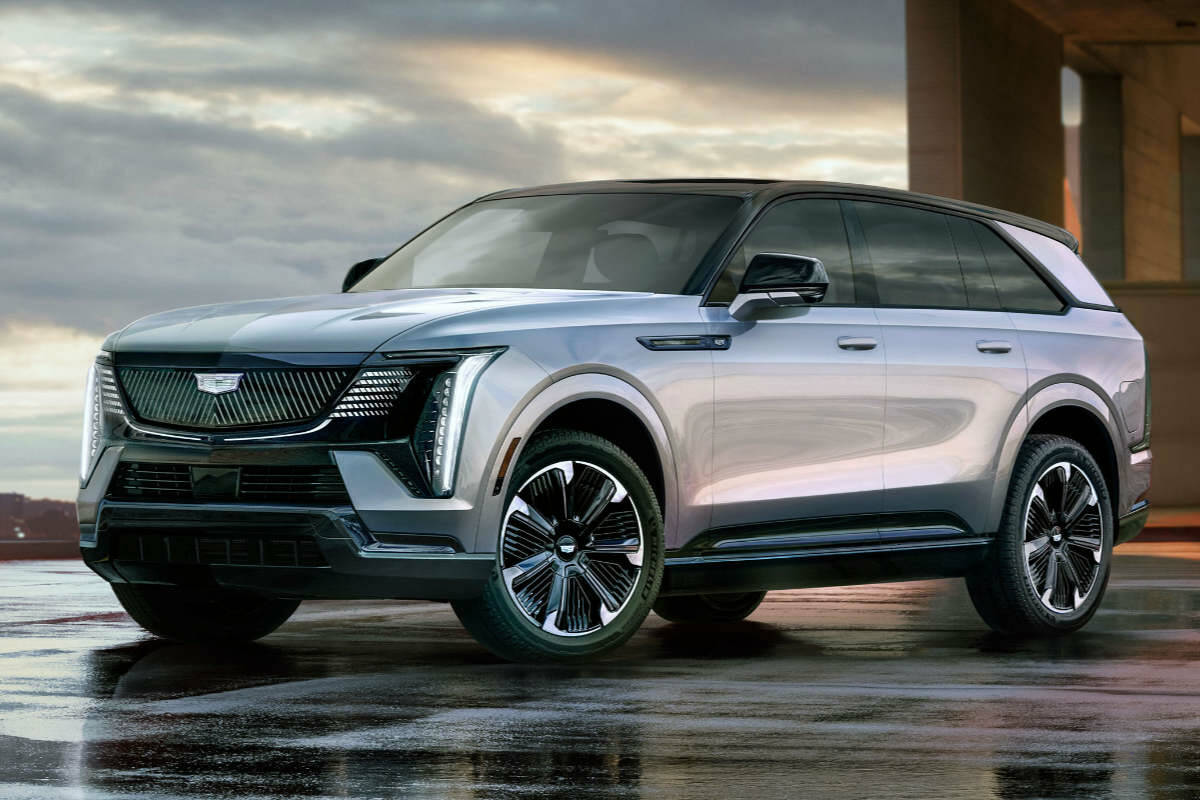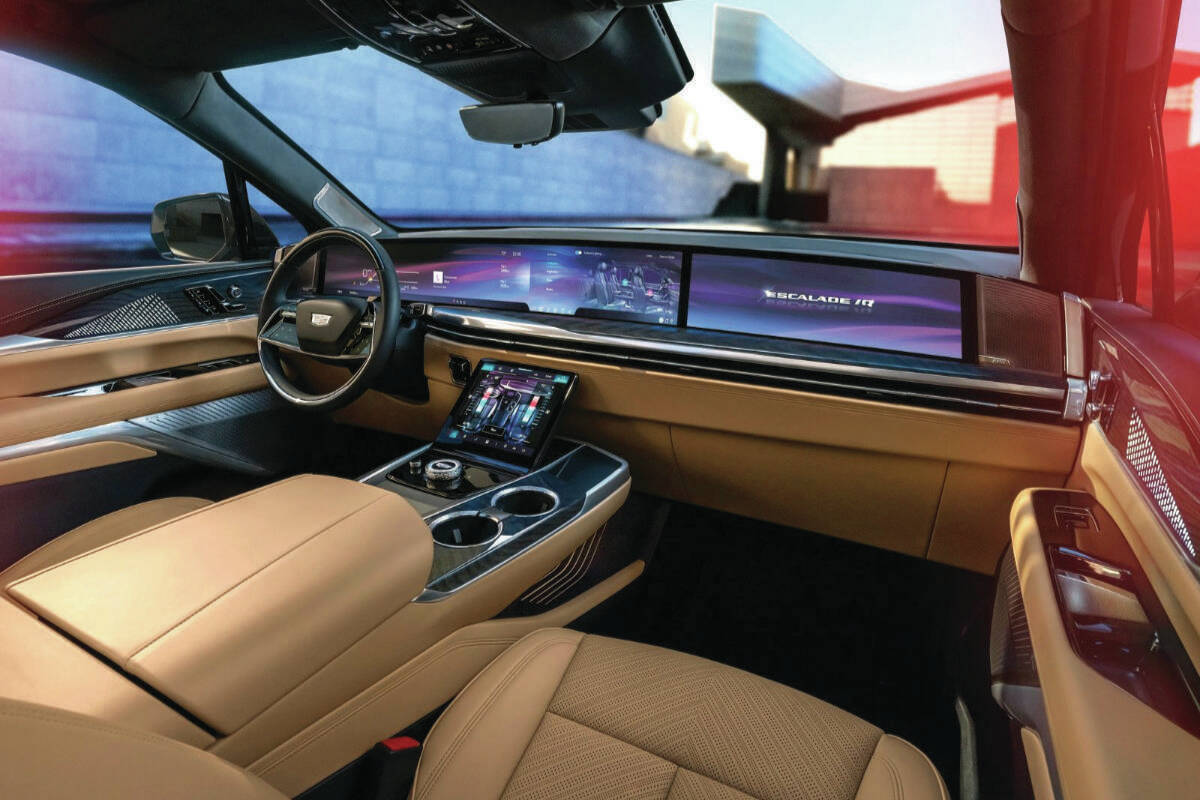And now there are three.
The announcement that Cadillac will begin delivering the Escalade IQ electric vehicle next summer follows the recently launched 2024 Lyriq utility vehicle and the announcement of the ultra-luxury Celestiq hatchback.
These three are just the beginning for Cadillac, which of course will add other electric sedans and utility vehicles on its path to a fully electrified future.
The full-size, seven-passenger Escalade IQ’s general shape identifies with its gasoline counterpart but differs greatly in the details. From the nonfunctional grille and unique headlights, to the swept-back roofline and L-shaped taillights, the IQ is a particularly stylish vehicle that projects an appropriately upscale aura.
For length, the IQ is between the gasoline-powered Escalade and the longer Escalade ESV, but the IQ has more distance between the front and rear wheels (wheelbase) than both. Despite this, both gasoline models offer a bit more legroom for all three rows of seats. The IQ has less cargo volume, but it makes up for some of that with an “eTrunk” beneath the hood that Cadillac says can transport two sets of golf clubs.
The IQ rides on General Motors’ Ultium platform that supports its various sizes of EVs, from the Chevrolet Equinox right on up to the GMC Hummer EV. Unique to the electric Escalade is an adaptive air suspension that can lower the ride height by five centimetres or raise it by 2.5 centimetres. Standard four-wheel steering, which can be activated at low speeds, significantly reduces turning radius. The available Arrival Mode can move the IQ diagonally into and out of tight parking spaces.
The interior is the very definition of modern. The curved glass dashboard includes a 35-inch driver’s display alongside a 25-inch infotainment screen. An 11-inch tablet-style screen is positioned on the floor console. It controls the ventilation and ambient lighting system’s 126 colour choices.
The IQ is equipped with front and rear electric motors supported by a 200-kilowatt-hour lithium-ion battery pack. In standard mode, the output is 680 horsepower and 615 pound-feet of torque. In Velocity Max mode, output increases to 750 horsepower and 785 pound-feet; Cadillac says accelerating to 60 mph (96 km/h) from rest should flash by in about five seconds.
The IQ’s 8,000-pound (3640-kilogram tow rating is similar to the gasoline Escalade’s capability.
The IQ is expected to provide about 720 kilometres of range on a full battery and it will charge at a rate of 59 kilometres for each hour plugged in to a 240-volt Level 2 home station. The rate increases to 160 kilometres in 10 minutes when plugged into a commercial 480-volt DC fast-charger, although such stations can be few and far between.
A Regen on-demand system provides braking/stopping force without the driver touching the brake pedal. This generates electricity that’s returned to the battery.
The IQ gets vehicle-to-home bi-directional charging, meaning it can power your home in the event of an outage. It can also be used to provide power to electric tools and other equipment.
Pricing will start at an estimated $175,000 in Canada, including destination charges. The standard features list includes massive 24-inch wheels and Cadillac’s Super Cruise semi-autonomous system that allows for hands-free driving on more than 400,000 miles (about 640,000 kilometres) of roads in the United States and Canada. Among the many operations, it can execute lane changes when passing slower traffic and warns when the driver isn’t paying attention to the road.
Standard active-safety technologies include front and rear emergency braking and pedestrian/cyclist detection/braking. Automatic parking assist can move the IQ into and out of a parallel or perpendicular spot.
Options include second row captain’s chairs with massaging function, dual headrest speakers with folding tray tables, second-row 12.6-inch screens and dual wireless phone charging. Another upgrade is a 40-speaker AKG Studio Reference audio system (a 19-speaker AKG setup is standard).
Considering the degree of style and performance, the 2025 Cadillac Escalade IQ should appeal to buyers of premium-grade utility vehicles who consider it a greener — at least in terms of fossil fuels — and more stylistic path to luxury-class travel.
What you should know: 2025 Cadillac Escalade IQ
Type: Full-size all-wheel-drive electric utility vehicle
Motors (h.p.): Front and rear electric (680; 750 in Velocity Max mode)
Transmission: Single-speed controller
Market position: The Escalade IQ is the third EV to be introduced by Cadillac as part of the brand’s long-term goal to transition out of internal combustion before the end of the decade. It appears to be an attempt to make larger utility vehicles seem less wasteful and more cutting edge.
Points: Attractive styling improves on the existing internal-combustion variant. • High-tech digital control screens dominate the dashboard. • Dual electric motors deliver significantly more power than the gasoline Escalade. • Not as much passenger and cargo space as you might think. • Near $200,000 base price (including tax) could send some buyers to competing brands.
Driver assist: Blind-spot warning with cross-traffic backup alert (std.); active cruise control (std.); front and rear emergency braking (std.); inattentive-driver alert (std.); lane-departure warning (std.); pedestrian warning (std.)
Le/100 km (city/hwy): n.a.
Base price (incl. destination): $175,000 (est.)
BY COMPARISON
Mercedes-Benz EQS SUV
Base price: $137,000
EQS sedan-based EV offers up to 536 h.p.; up to 490 km of range.
BMW iX xDrive
Base price: $129,500
2024 AWD EV produces up to 610 h.p. and provides 480 km of range.
Audi Q8 e-tron
Base price: $95,950
355-h.p. AWD SUV and Sportback models offer up to 475 km of range.
– written by Malcom Gunn, Managing Partner at Wheelbase Media
If you’re interested in new or used vehicles, be sure to visit TodaysDrive.com to find your dream car today! Like us on Facebook and follow us on Instagram



